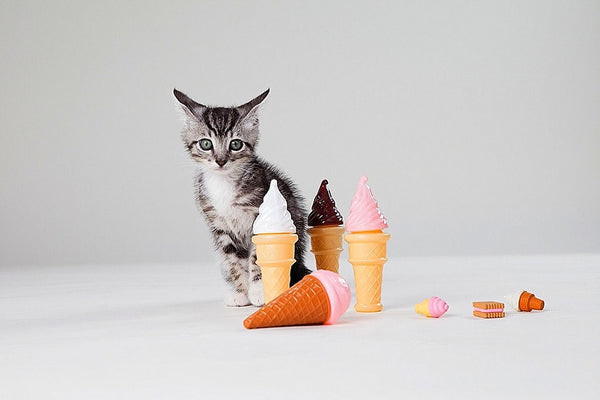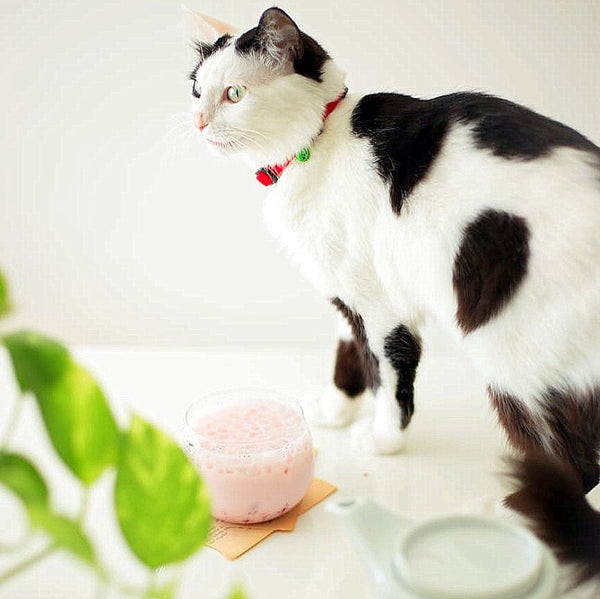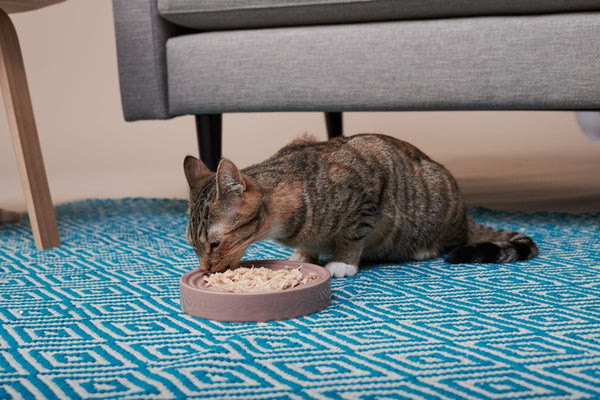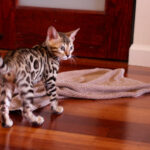Ice cream, a delightful concoction of creamy sweetness, is a beloved treat for humans, especially on a hot day. The temptation to share this delicious indulgence with our feline companions can be strong. If you’ve ever wondered, “Can Cats Have Ice Cream?”, the simple answer leans towards no. While not inherently poisonous to cats like some human foods, ice cream is far from a healthy or safe treat for them. Offering your cat more than a tiny lick can lead to various health issues, both in the short and long run.
In this comprehensive guide, we will explore:
- Appropriate, cat-safe serving sizes of ice cream (if any).
- The potential negative consequences of overindulging your cat with ice cream.
- Considerations for different ice cream flavors and toppings and their safety for cats.
Ice Cream and Cats: 5 Potential Problems You Need to Know
While a minuscule taste of ice cream might not cause immediate alarm, it’s crucial to understand that ice cream is generally not recommended for cats, even in small amounts. Nutrition experts advise that if you must give ice cream, average-sized cat breeds such as Siamese or Persian cats should have no more than a teaspoon. Larger breeds like Ragdolls or Maine Coons might tolerate up to two teaspoons. However, this treat should be an extremely rare occasion, ideally no more than once a month, due to the following significant risks:
- Digestive upset and gastrointestinal issues
- Lactose intolerance and potential dairy allergies
- Brain freeze and discomfort
- Nutritional imbalance and dietary issues
- Development of fussy eating habits
 A cute cat with a questioning look, seemingly unsure about a plastic ice cream toy. Alt text: Disappointed cat posing with a plastic ice cream toy, longing for real treats.
A cute cat with a questioning look, seemingly unsure about a plastic ice cream toy. Alt text: Disappointed cat posing with a plastic ice cream toy, longing for real treats.
Gastrointestinal Distress: Why Ice Cream Can Upset Your Cat’s Stomach
Cats are obligate carnivores, meaning their digestive systems are primarily designed to process meat. Ice cream, being a dairy and sugar-rich product, is far removed from their natural dietary needs. Overconsumption of ice cream can significantly disrupt their delicate digestive balance and lead to gastrointestinal problems. These can manifest as:
- Vomiting
- Diarrhea
- Gas and bloating
- Abdominal pain
- Loss of appetite
A primary reason for these digestive issues in cats is lactose intolerance. Kittens can digest lactose, the sugar found in milk, thanks to the enzyme lactase which helps break it down. However, as cats mature and transition to solid food, their lactase production decreases. This means adult cats often struggle to digest lactose, leading to discomfort and digestive upset after consuming dairy products like ice cream, milk, and cheese.
Beyond lactose, the high fat content in ice cream is another significant gastrointestinal trigger for cats. A cat’s diet should ideally contain a moderate amount of fat, around 20% of their daily intake. Ice cream, along with other fatty human foods like beef, pork, lamb, eggs, and fried snacks, can overwhelm their digestive system, causing stomach upset and potentially contributing to more serious conditions over time.
Dairy Allergies: A Serious Reaction Beyond Lactose Intolerance
It’s important to differentiate between lactose intolerance and a dairy allergy. Lactose intolerance is a digestive issue, where the body struggles to process lactose. A dairy allergy, on the other hand, is an immune system response to specific milk proteins, primarily casein. The body mistakenly identifies these proteins as harmful and triggers an allergic reaction.
Even a small amount of ice cream can trigger a dairy allergy in sensitive cats, leading to a range of symptoms, including:
- Vomiting and diarrhea
- Skin irritation, itching, and rashes
- Inflammation
- Respiratory problems like coughing or wheezing
- Hair loss
While some cat owners consider vegan ice cream alternatives made with lactose-free milk, soy milk, almond milk, or coconut oil, these are still not healthy options for cats. These alternatives might be dairy-free, but they are often still high in sugar and fat, posing similar health risks as traditional ice cream.
Brain Freeze: More Traumatic Than Treat
The internet is filled with videos of cats experiencing brain freeze after eating ice cream, often presented as humorous content. However, animal welfare organizations like Cats Protection emphasize that brain freeze can be a genuinely unpleasant and even traumatic experience for cats.
Brain freeze, or ice cream headache, is caused by the rapid cooling and subsequent rewarming of blood vessels in the sinuses, leading to sudden pain. While the pain is short-lived, it can be intense and startling for a cat. Furthermore, the sudden temperature shock can potentially cause tooth sensitivity in some cats. If your cat shows signs of brain freeze after consuming cold treats, it’s best to avoid giving them ice cream or similar chilled foods altogether.
Nutritional Imbalance: Empty Calories and Unwanted Ingredients
Ice cream offers minimal nutritional value for cats and can actually contribute to nutritional imbalances if given regularly. Here’s a breakdown of the typical nutritional content of ice cream:
| Nutritional Markers | Approximate amount per 100 grams |
|---|---|
| Fat | 11 grams |
| Protein | 3.5 grams |
| Carbohydrates (including sugar) | 24 grams |
| Cholesterol | 44 milligrams |
| Sodium | 80 milligrams |
| Calories | 207 calories |
As you can see, ice cream is high in calories, fat, carbohydrates, and sugar, while offering very little protein or essential nutrients that cats need. Overconsumption of ice cream can lead to several health problems due to nutrient imbalances:
- Excess Carbohydrates: Cats have limited ability to digest and utilize carbohydrates. Too many carbs can lead to digestive upset, weight gain, diabetes, and stomach sensitivity.
- High Fat and Cholesterol: Excessive fat intake can contribute to obesity, heart disease, pancreatitis, and liver problems in the long run.
- High Sodium: Sodium toxicity is a serious concern for cats. Excessive salt intake from ice cream can cause salt poisoning, leading to symptoms like lethargy, vomiting, incoordination, loss of appetite, and seizures.
Fussy Eating Habits: Developing a Taste for Unhealthy Treats
Just like humans, cats can develop a preference for unhealthy, high-fat, and sugary snacks. Regularly offering ice cream or other “junk food” can lead to cats becoming picky eaters. They may start to crave these addictive, palatable treats and refuse their regular, nutritionally balanced cat food.
This can create a cycle of unhealthy eating, where cats prioritize empty-calorie treats over essential nutrients, leading to malnutrition and various health issues in the long run.
Why Do Cats Seem to Want Ice Cream? Debunking the Sweet Tooth Myth
It’s a common misconception that cats are drawn to ice cream because of its sweetness. In reality, cats lack the taste receptors to detect sweetness. They cannot taste sweet flavors in the same way humans do.
If your cat shows interest in ice cream or other sweet human snacks, it’s more likely due to the high fat content and appealing texture. The creamy, smooth texture of ice cream, combined with its rich fat content, can be enticing to cats, even though they don’t perceive it as sweet. This is why it’s crucial to keep human junk food, including ice cream, out of reach of your feline companions.
 A curious cat intently watching a person holding a bowl of snacks, hinting at wanting to share. Alt text: Mischievous cat eyeing human snacks, contemplating a treat heist.
A curious cat intently watching a person holding a bowl of snacks, hinting at wanting to share. Alt text: Mischievous cat eyeing human snacks, contemplating a treat heist.
If your cat frequently begs for snacks between meals, it might be a sign that their regular diet is not meeting their nutritional needs. Cats require a diet rich in high-quality animal protein to feel full and satisfied and to obtain sufficient energy. If their food is low in protein (below 50%), they may feel hungry and seek out extra calories from treats or even non-food items like houseplants or fabrics.
The ideal diet for cats consists of grain-free, high-protein wet food. Prioritize foods made with lean meat protein sources like chicken, turkey, tuna, salmon, shrimp, or prawn. Dry food, while often cheaper, is usually heavily processed and contains less real meat. Kibble often includes:
- Processed meat and fish meals (lower quality protein sources)
- Grains like corn and rice (unnecessary fillers for cats)
- Starch and sugar binders (to hold kibble shape)
- Plant or animal fat (as palatability enhancers, leading to potential addiction)
- Artificial colors and preservatives (questionable health impact)
These ingredients are not as biologically appropriate or easily digestible for cats compared to whole meat and organs. Dry food can also increase the risk of dehydration and related health issues like urinary tract problems and kidney disease.
Untamed: Nourishing Your Cat with Biologically Appropriate Food
For cat owners seeking the best nutrition for their feline friends, Untamed offers a superior alternative to conventional cat food. Our wet food formulas are crafted with high percentages of human-grade, whole meat and are free from harmful and unnecessary ingredients, such as:
- Meat derivatives (unspecified and low-quality meat sources)
- Plant proteins (not biologically appropriate for obligate carnivores)
- Grains (fillers that offer minimal nutritional value)
- Added sugar (unnecessary and unhealthy)
- Artificial additives (colors, flavors, and preservatives)
 A close-up of a delicious Untamed cat food pouch, showcasing its gourmet appearance. Alt text: Untamed cat food pouch, highlighting gourmet wet food for feline health.
A close-up of a delicious Untamed cat food pouch, showcasing its gourmet appearance. Alt text: Untamed cat food pouch, highlighting gourmet wet food for feline health.
Untamed food is available in both succulent gravy and jelly textures, containing 60%–63% whole meat, naturally rich in taurine and essential B and E vitamins. Untamed stands out from typical cat food brands because we:
-
Prioritize Premium Protein: Our recipes feature top-quality proteins like fresh chicken breast and liver, tuna, salmon, mackerel, and sardine. These support muscle development and help prevent hairballs.
-
Use Vet-Formulated Recipes: Veterinarians have carefully formulated our recipes to ensure optimal nutrient balance. Switching to Untamed provides complete and balanced nutrition, eliminating concerns about dietary deficiencies.
-
Create Irresistible Flavors: We gently steam-cook our food to preserve the natural aroma and taste of the meat. Even the most discerning cats are drawn to our tender, flavorful meals. Try our tempting varieties:
- Chocka Chicken with Ham in Gravy
- Tuck-in Tuna with Shrimp in Gravy
- Chocka Chicken with Duck in Jelly
- Tuck-in Tuna with Salmon in Jelly
- Tuck-in Tuna with Shrimp in Jelly
-
Avoid Common Allergens: Our recipes are free from common feline allergens. We also offer single-protein options designed for cats with food sensitivities or allergies.
We’re eager to learn more about your cat’s specific needs! Take our TRY NOW quiz [link to quiz] to receive a personalized taster pack at a special price.
The Untamed Effect: Supporting Your Cat’s Lifelong Well-being
Untamed food is designed to benefit cats at every stage of life. We focus on promoting optimal health by respecting a cat’s natural carnivorous needs.
 A collage showing happy and healthy cats in various playful poses, representing the vitality Untamed food provides. Alt text: Happy and healthy cats enjoying life, showcasing the benefits of Untamed diet.
A collage showing happy and healthy cats in various playful poses, representing the vitality Untamed food provides. Alt text: Happy and healthy cats enjoying life, showcasing the benefits of Untamed diet.
Here’s what our satisfied customers report about the positive changes they’ve observed in their cats after switching to Untamed:
| Timeline | The Untamed Effect |
|---|---|
| 1–2 weeks | – Improved digestion and nutrient absorption – Noticeably cleaner litter box – Increased hydration |
| 2–4 months | – Shinier, healthier coat – Reduced hairballs – Stronger muscles and bones – Increased energy levels |
| Long-term | – Healthy weight management – Robust immune system – Fewer illnesses – Graceful aging |
Convenient and Sustainable Cat Food Delivery
Untamed offers a hassle-free way to keep your cat’s pantry stocked with nutritious food. We provide next-day delivery directly to your doorstep with no shipping fees. For continuous supply, our subscription service ensures you never run out of your cat’s favorite meals. You can easily adjust, pause, or cancel your subscription at any time.
Ready to experience the Untamed difference? Here’s how to get started:
- Take our TRY NOW quiz [link to quiz].
- Create a customized meal plan for your cat.
- Place your order.
Untamed is committed to sustainability, operating with a neutral carbon footprint and using 100% recyclable packaging. Our ingredients, including meat and fish, are sourced ethically and sustainably.
Flavor Focus: Are Some Ice Cream Flavors Worse for Cats?
While the general advice is to avoid ice cream for cats, you might wonder if certain flavors pose greater risks. Is strawberry ice cream slightly better than mango, for instance? Regardless of flavor, the serving guidelines remain the same: a very small amount (teaspoon or two at most) is the absolute limit, and only on rare occasions.
Keep in mind that most commercially produced ice creams rely heavily on artificial flavorings, colors, and additives to achieve the desired taste and appearance, rather than using real fruit. These artificial ingredients can further irritate your cat’s digestive system. If you were to consider offering a tiny taste, artisanal ice cream with minimal artificial additives might be marginally preferable, but still not recommended. Crucially, avoid ice cream with the following dangerous ingredients and toppings:
- Raisins and Grapes: Highly toxic to cats, even small amounts can cause kidney failure.
- Nuts: Many nuts are choking hazards, and macadamia nuts are toxic to cats.
- Alcohol: Extremely dangerous for cats, affecting their central nervous system and potentially causing death.
- Cherries: Contain cyanide and can cause poisoning.
- Xylitol: An artificial sweetener extremely toxic to cats, causing liver damage.
- Chocolate and Caffeine: Stimulants that can cause vomiting, diarrhea, hyperactivity, tremors, and seizures in cats.
While cats might occasionally be tempted by desserts containing ice cream, like ice cream cake or banana splits, these are all very unhealthy options. For a cooling treat on a hot day, a spoonful of plain, chilled yogurt is a much safer and healthier alternative. The lactose in yogurt is partially broken down during fermentation, making it easier for cats to digest and less likely to cause digestive upset.
Explore our other guides to learn more about what is safe and unsafe for cats to eat:

